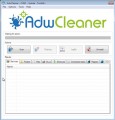If annoying ads signed with eAdvisor popping up in your internet browser then most probably the eAdvisor adware get installed on your PC. The eAdvisor is an adware (sometimes called ‘ad-supported’ software). It is a type of potentially unwanted software that designed to open a ton of unwanted pop-up ads. Unlike viruses, the ad supported software will not delete or infect your files, but its actions will cause some problems with your internet browser. This is because, it will infect your PC system, get full access to your internet browsers like Chrome, Mozilla Firefox, MS Edge and Internet Explorer and be able to modify their settings. Of course, it did not ask you for permission and do it secretly as possible. Once your internet browser settings will be changed, you will be rerouted to unwanted advertisements, some of which can lead to dangerous or misleading web sites. For this reason, we recommend that you start the clean up of your system as quickly as possible and thereby delete eAdvisor popup ads.
The ad-supported software can change the settings of the Chrome, Mozilla Firefox, Internet Explorer and Microsoft Edge, but often that a malicious software such as this can also infect all types of web browsers by changing their desktop shortcuts. Thus forcing the user each time open the internet browser to see eAdvisor unwanted ads.
The adware may insert lots of advertisements directly to the web-sites that you visit, creating a sense that the advertising links has been added by the creators of the site. Moreover, a legal ads may be replaced on the fake advertisements, that will offer to download and install various unnecessary and harmful programs. Moreover, the ad-supported software has the ability to collect lots of personal information about you (your ip address, what is a web page you are viewing now, what you are looking for on the Internet, which links you are clicking), which can later transfer to third parties.
We recommend to remove the adware, which redirects your web browser on the eAdvisor annoying page, as soon as you found this problem, as it can direct you to web-resources which may load other harmful software on your machine.
How does your personal computer get infected with eAdvisor
The adware spreads with a simple but quite effective way. It’s integrated into the install package of various free software. Thus on the procedure of installation, it’ll infect your web-browser. To avoid adware infection, you just need to follow a few simple rules: carefully read the ‘Terms of Use’ and the ‘License’, select only a Manual, Custom or Advanced installation mode, which enables you to make sure that the program you want to install, thereby protect your computer from the malicious software such as this ‘ad supported’ software which opens the eAdvisor advertisements.
How to manually remove eAdvisor pop-ups
This useful removal guide for the eAdvisor redirect. The detailed procedure can be followed by anyone as it really does take you step-by-step. If you follow this process to delete eAdvisor advertisements let us know how you managed by sending us your comments please.
- Uninstall suspicious and unknown programs by using Windows Control Panel
- Get rid of eAdvisor advertisements from Mozilla Firefox
- Get rid of eAdvisor advertisements from Chrome
- Delete eAdvisor advertisements from IE
- Disinfect the browser’s shortcuts
- Remove unwanted Scheduled Tasks
Uninstall suspicious and unknown programs by using Windows Control Panel
First, you should try to identify and remove the application that causes the appearance of annoying advertisements and browser redirect to unwanted web-sites, using the ‘Uninstall a program’ which is located in the ‘Control panel’.
Windows 8, 8.1, 10
Press Windows key
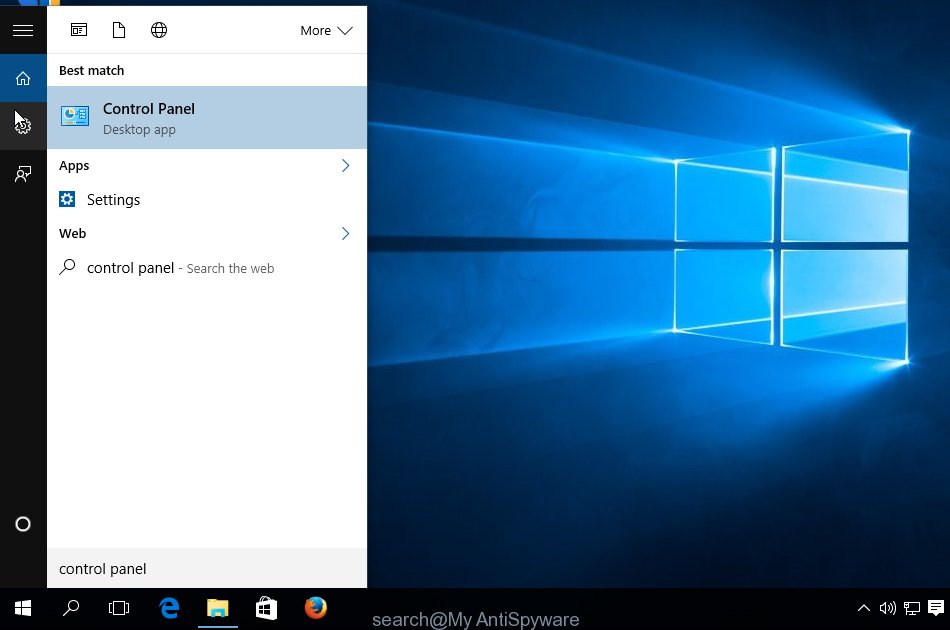
When the ‘Control Panel’ opens, click the ‘Uninstall a program’ under Programs category as shown in the figure below.
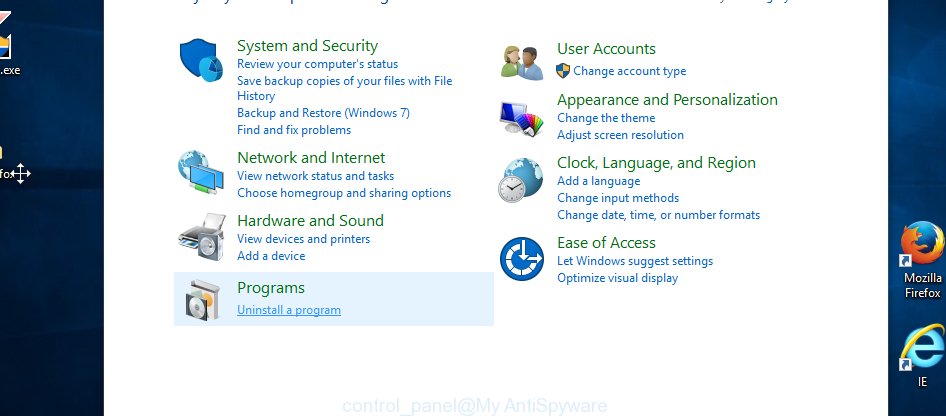
You will see the ‘Uninstall a program’ panel as shown below.

Very carefully look around the entire list of installed software. Most likely, one or more of them are responsible for the web browser redirect to unwanted eAdvisor pop-up ads. If you have many programs installed, you can help simplify the search of malicious applications by sort the list by date of installation. Once you have found a suspicious, unwanted or unused program, right click to it and press ‘Uninstall’.
Windows XP, Vista, 7
First, click ‘Start’ button and select ‘Control Panel’ at right panel as on the image below.
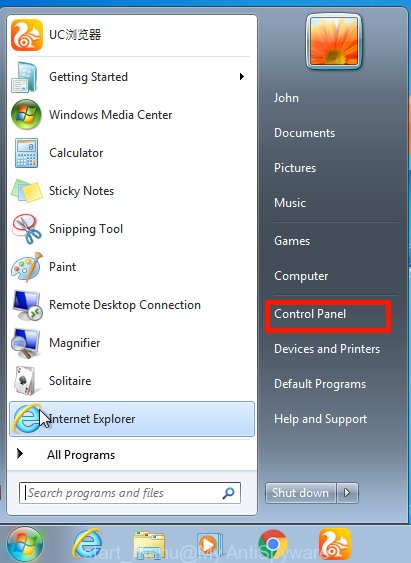
When the Windows ‘Control Panel’ opens, you need to press ‘Uninstall a program’ under ‘Programs’ as shown below.
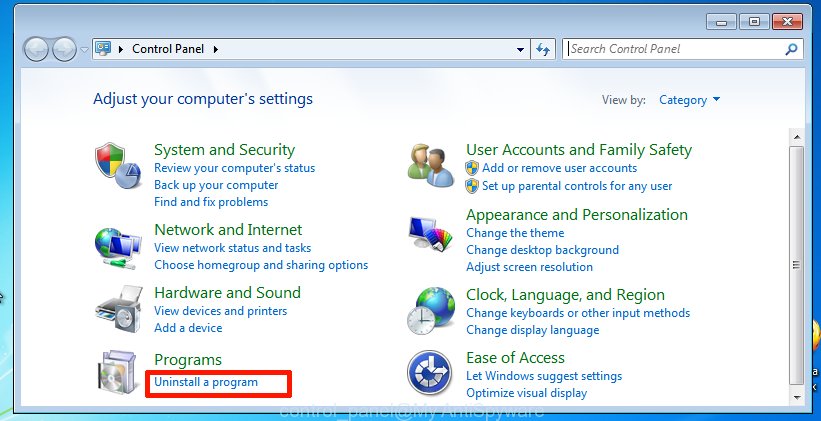
You will see a list of programs installed on your computer. We recommend to sort the list by date of installation to quickly find the software that were installed last. Most likely they responsibility for the appearance of annoying advertisements and internet browser redirect. If you are in doubt, you can always check the program by doing a search for her name in Google, Yahoo or Bing. When the application, you need to remove, is found, simply click on its name, and then click ‘Uninstall’ as shown below.
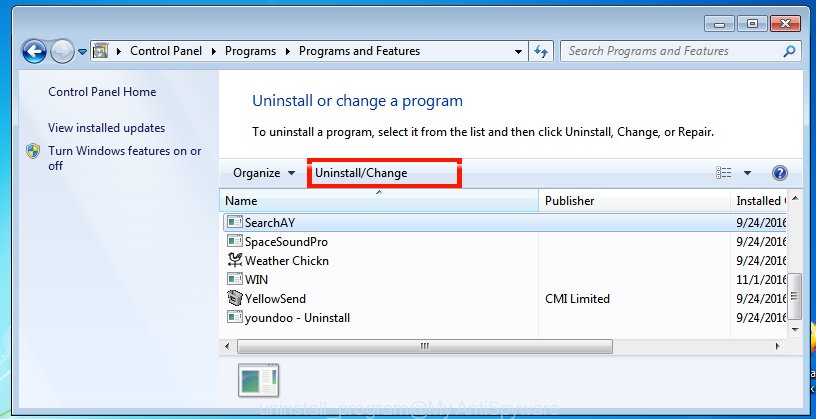
Get rid of eAdvisor advertisements from Mozilla Firefox
First, launch the Firefox. Next, click the button in the form of three horizontal stripes (![]() ). It will open the drop-down menu. Next, press the “Help” button (
). It will open the drop-down menu. Next, press the “Help” button (![]() ).
).

In the Help menu, press the “Troubleshooting Information”. In the upper-right corner of the “Troubleshooting Information” page, press “Refresh Firefox” button.

Confirm your action, press the “Refresh Firefox”.
Get rid of eAdvisor advertisements from Chrome
Reset Google Chrome settings is a easy way to remove the malware and adware, as well as to restore the web-browser’s settings that have been modified by ‘ad supported’ software.

- Now start the Google Chrome and press Menu button (small button in the form of three horizontal stripes).
- It will open the Google Chrome main menu. Select “Settings” option.
- You will see the Google Chrome’s settings page. Scroll down and click “Show advanced settings” link.
- Scroll down again and click the “Reset settings” button.
- The Google Chrome will show the reset profile settings page as shown on the image above.
- Next, click the “Reset” button.
- Once this task is finished, your web browser’s settings will be restored to their original defaults. This will reset your home page, newtab page and search provider by default.
- To learn more, read the post How to reset Google Chrome settings to default.
Delete eAdvisor advertisements from IE
First, launch the IE, then click ![]() button. Next, click “Internet Options” like below.
button. Next, click “Internet Options” like below.

In the “Internet Options” screen select the Advanced tab. Next, click the “Reset” button. The Internet Explorer will display the “Reset Internet Explorer” settings dialog box. Select the “Delete personal settings” check box and click Reset button.

You will now need to reboot your computer for the changes to take effect. It will restore the Microsoft Internet Explorer’s settings such as start page and search provider by default to default state, disable ad-supported browser’s extensions and thereby remove the redirect to eAdvisor annoying web site.
Disinfect the browser’s shortcuts
Once the adware is started, it can also alter the browser’s shortcuts, adding an argument such as “http://site.address” into the Target field. Due to this, every time you open the web-browser, it will be redirected to an annoying advertisements.
To clear the web-browser shortcut, right-click to it and select Properties. On the Shortcut tab, locate the Target field. Click inside, you will see a vertical line – arrow pointer, move it (using -> arrow key on your keyboard) to the right as possible. You will see a text that starts with “http://” that has been added here. You need to remove it.
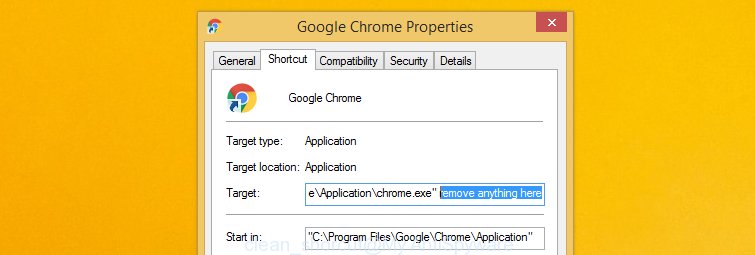
When the argument is removed, click the OK button. You need to clean all shortcuts of all your web browsers, as they may be infected too.
Remove unwanted Scheduled Tasks
If the unwanted eAdvisor web-site opens automatically on Windows startup or at equal time intervals, then you need to check the Task Scheduler Library and remove all the tasks that have been created by malicious application.
Press Windows and R keys on the keyboard simultaneously. This shows a dialog box that titled as Run. In the text field, type “taskschd.msc” (without the quotes) and press OK. Task Scheduler window opens. In the left-hand side, press “Task Scheduler Library”, as shown in the figure below.
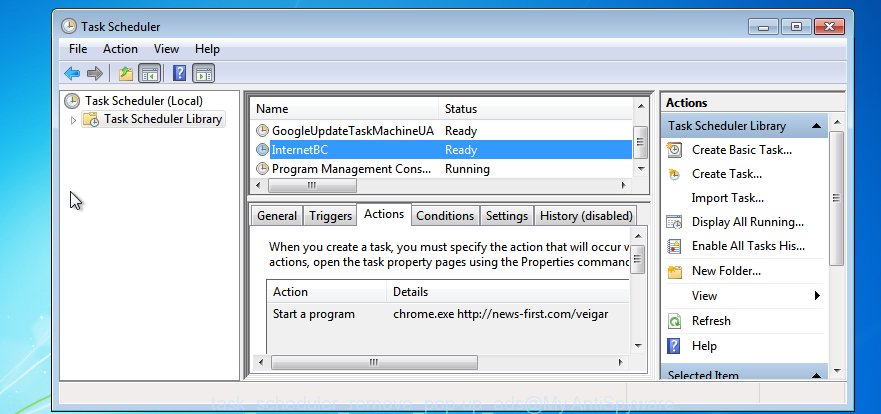
Task scheduler
In the middle part you will see a list of installed tasks. Select the first task, its properties will be show just below automatically. Next, press the Actions tab. Pay attention to that it launches on your PC. Found something like “explorer.exe http://site.address” or “chrome.exe http://site.address”, then you need delete it. If you are not sure that executes the task, check it through a search engine. If it’s a component of the malicious program, then this task also should be removed.
Having defined the task that you want to delete, then click on it with the right mouse button and select Delete as on the image below.

Delete a task
Repeat this step, if you have found a few tasks that have been created by ‘ad-supported’ program. Once is finished, close the Task Scheduler window.
How to delete eAdvisor automatically
Manual removal is not always as effective as you might think. Often, even the most experienced users can not completely remove eAdvisor pop-up ads from the infected computer. This is because the ad-supported software can hide its components which are difficult for you to find out and get rid of completely. This may lead to the fact that after some time, the ‘ad supported’ software again infect your system and it will start to display annoying eAdvisor pop-up ads. Moreover, I want to note that it is not always safe to get rid of adware manually, if you do not have much experience in setting up and configuring the computer.
I suggest using the Malwarebytes Free that are completely clean your personal computer. It’s an advanced malware removal program developed by (c) Malwarebytes lab. This program uses the world’s most popular anti-malware technology. It is able to help you delete browser hijackers, malware, ad supported software, toolbars, ransomware and other security threats from your machine for free.
Now, click the link below to download Malwarebytes Free on your personal computer. Save it on your Windows desktop or in any other place.
327736 downloads
Author: Malwarebytes
Category: Security tools
Update: April 15, 2020
Once the download is done, close all applications on your PC. Next, launch the setup file named mb3-setup. If the “User Account Control” dialog box pops up as shown on the image below, click the Yes button.

It will display the “Setup wizard” that will help you install Malwarebytes on your personal computer. Follow the prompts and don’t make any changes to default settings.

Once setup is finished successfully, press Finish button. Then Malwarebytes will automatically start and you can see its main screen as shown below.

Now click the “Scan Now” button for scanning your personal computer for the ‘ad supported’ software which cause a redirect to eAdvisor. When the ad-supported software or malware is found, the number of the detected objects will change accordingly. Wait until the the scanning is finished. Please be patient.
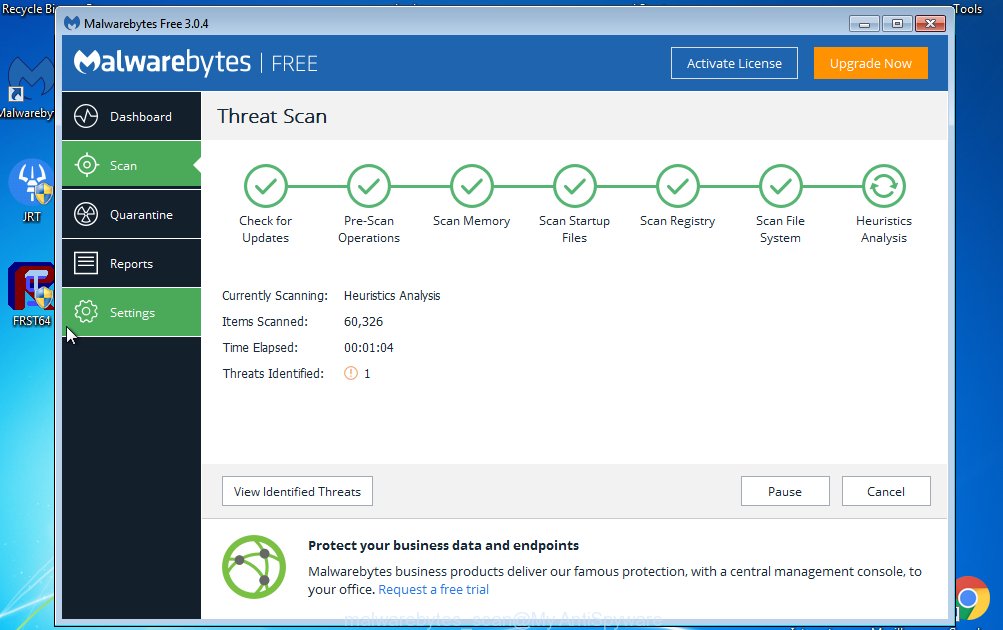
Once the scan is finished, you can check all threats detected on your computer. Make sure all entries have “checkmark” and press “Quarantine Selected” button. The Malwarebytes will begin removing malware and adware which cause eAdvisor advertisements. Once disinfection is finished, you may be prompted to restart your PC.
I suggest you look at the following video, which completely explains the procedure of using the Malwarebytes program to remove adware and other malware.
Stop eAdvisor pop-ups and other unwanted pages
To increase your security and protect your system against new annoying ads and malicious web-pages, you need to use application that blocks access to harmful ads and sites. Moreover, the program can block the display of intrusive advertising, that also leads to faster loading of web-sites and reduce the consumption of web traffic.
Download AdGuard program by clicking on the following link.
27037 downloads
Version: 6.4
Author: © Adguard
Category: Security tools
Update: November 15, 2018
When the download is done, run the file named adguardInstaller. You will see the “Setup Wizard” screen like below.

Follow the prompts. When the installation is complete, you will see a window as shown below.

You can press “Skip” to close the installation program and use the default settings, or press “Get Started” button to see an quick tutorial that will allow you get to know AdGuard better.
In most cases, the default settings are enough and you do not need to change anything. Each time, when you start your computer, AdGuard will launch automatically and stop popup ads, pages such as eAdvisor, as well as other malicious or misleading web-pages. For an overview of all the features of the application, or to change its settings you can simply double-click on the AdGuard icon, which is located on your Windows desktop.
If the problem with eAdvisor redirect is still remained
If MalwareBytes cannot remove eAdvisor pop-ups, then we suggests to use the AdwCleaner. AdwCleaner is a free removal tool for adware, browser hijackers, PUPs, toolbars.
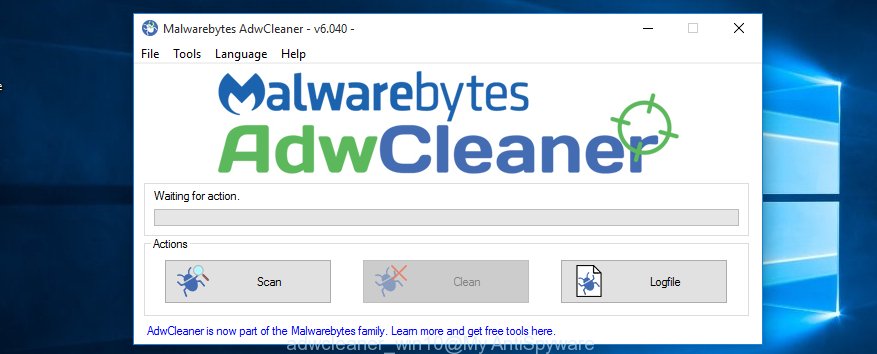
- Download AdwCleaner from the link below.
AdwCleaner download
225791 downloads
Version: 8.4.1
Author: Xplode, MalwareBytes
Category: Security tools
Update: October 5, 2024
- Double click the AdwCleaner icon. Once the utility is started the main screen will appear as shown on the image above.
- Now, press the “Scan” button to begin checking your PC for the adware that generates eAdvisor ads.
- Once the system scan is complete, AdwCleaner will open a scan report. Review the report and then click “Clean” button. It will display a dialog box, click “OK” button.
The following video explains the step-by-step guide above on how to get rid of ad supported software with AdwCleaner.
Finish words
Now your personal computer should be free of the eAdvisor redirect. Remove AdwCleaner. We suggest that you keep AdGuard (to help you block unwanted pop-ups and unwanted malicious web sites) and Malwarebytes (to periodically scan your PC for new malware and ad-supported software). Probably you are running an older version of Java or Adobe Flash Player. This can be a security risk, so download and install the latest version right now.
If you are still having problems while trying to delete eAdvisor pop-ups from your computer, then ask for help in our Spyware/Malware removal forum.

